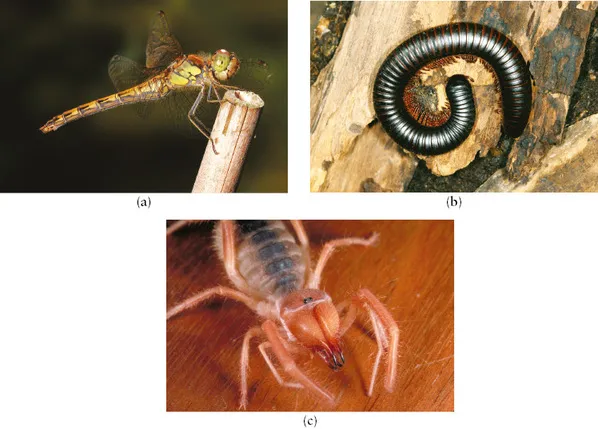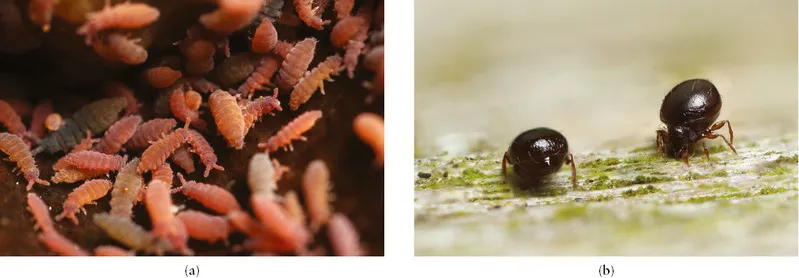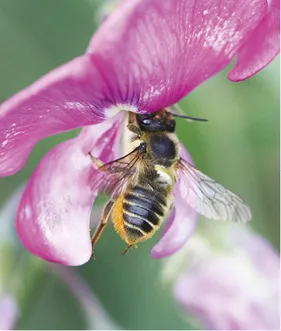![]()
1 Introduction to the Arthropods
What Is an Arthropod?
The subjects of this book are the arthropods that live among us, primarily the insects but also some of their relatives, such as arachnids, millipedes, centipedes, and a few crustaceans. When formally classified, these animals are placed in the phylum Arthropoda, which comprises a huge number of species with a tremendous diversity of forms and habits. Nonetheless, all arthropods share certain features that together define them as a distinct form of life:
• All arthropods have a body supported by a hardened external skeleton (exoskeleton), a reverse type of engineering compared to our internal skeleton. To allow growth, this exoskeleton must be periodically shed, and a new one rebuilt.
• The body of an arthropod is divided into segments, a feature shared by some other animal groups, such as earthworms (phylum Annelida) and velvet worms (phylum Onychophora).
• The appendages of arthropods—their legs, antennae, and mouthparts—are jointed. This is the feature that defines the phylum. (In Greek, arthropod means “jointed foot.”)
• Internally, the nerve cord runs along the lower (ventral) part of the body and is not enclosed in a protective spinal column. These features contrast with those found in phylum Chordata to which we belong.
• Blood is moved by the aid of a tube-like heart, located along the back (dorsal) part of the body.
• The overall body arrangement is bilaterally symmetrical, so that, if the body were cut through the center from head to tail, the two halves would be a mirror image of one another.
The Diversity and Abundance of Arthropods
The arthropods are, by far, the most diverse life form on the planet. Insects alone, with approximately 970,000 known species, comprise over one-half of all kinds of life known to occur on the planet. Yet despite the impressive numbers, these reflect only “known species,” ones that have been suitably described in the scientific literature and accepted as distinct species. This number represents only a small fraction of the number of species estimated to be present on the planet today. This number is also a tiny fraction of all the insects that ever were on the planet. It has been suggested that perhaps 95% of all insects that have ever existed, since their first appearance some 400 million years ago (mya), are now extinct.
Today, the number of insect species thought to occur is often estimated at about four to five million species. The great majority of these, at least 80%, remain unknown to science so far. Progress is being made to close this gap, with over 7,000 new insect species being described annually, over 20 per day on average. At this rate of new discovery, impressive as it is, perhaps we can expect a full catalog of the five million insects to be ready in about 550 years or so.
A much more difficult question to answer is “How abundant are insects and other arthropods in terms of total population numbers?” One of the problems is that the overwhelming number of arthropods are minute and live in soil. For example, one of the first attempts at counting all of the arthropods in a sample of soil was done in an English pasture during November 1943. About 2.5 billion arthropods were estimated per hectare, with mites comprising some 62% and springtails 23% of the total number. On the basis of surveys such as this it has been estimated that the insects, springtails, mites, and other land-dwelling arthropods outnumber humans by as much as 250 million to 1. Furthermore, these arthropods collectively comprise over 80% of the total biomass of the terrestrial animals, far outweighing all the other land dwellers such as earthworms, reptiles, birds, and mammals.
The Many Roles of Arthropods
If all mankind were to disappear, the world would regenerate back to the rich state of equilibrium that existed ten thousand years ago. If insects were to vanish, the environment would collapse into chaos. (E. O. Wilson, The Diversity of Life)
Although small in size, arthropods, in their tremendous numbers, collectively account for the most biomass of all land animals. In the Amazon rain forest, the weight of just one family of insects, the ants, is estimated to be four times more than all the mammals, birds, fish, reptiles, and amphibians combined. Furthermore, the roles of arthropods in ecosystems are myriad, but central to the functioning of planet Earth:
Pollination of flowering plants. Insects are essential to the pollination of most flowering plants, and many of the flowering plants are the result of coevolution with their insect pollinators. The tremendous variety of flower types reflect different ways that plants have evolved to more efficiently attract pollinators. In response, new species of insects have arisen to better exploit these sources of nectar and pollen. In addition to native plants, essentially all fruits, vegetables, and many of the forage crops (e.g., clover, alfalfa) are dependent on insects to produce seed.
Recycling plant and animal matter. Many insects develop by feeding on dead plant matter, dead animal matter, or animal dung. In this role, they function as macrodecomposers that are in the first-line “clean-up crew” essential to the recovery and recycling of nutrients. Through insect feeding, these substances are broken down into much smaller particles and partially digested, which greatly accelerates the process of decay that frees the nutrients to nourish later generations of plants. In the absence of insects, nutrient-recycling systems bre...




